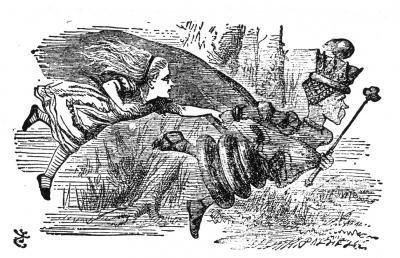The Red Queen hypothesis, a popular idea in evolution named after Lewis Carroll's character who in "Through the Looking Glass" described her country as a place where "it takes all the running you can do, to keep in the same place", recently got studied by a group of researchers who were thinking beyond the death of individual species - they examined how the lack of new emerging species also contributes to extinction.
Environmental brochures highlight fears about groups of animals, such as frogs or the "big cats," going extinct. But in science that is only part of the story.
"Virtually no biologist thinks about the failure to originate as being a major factor in the long term causes of extinction," said Charles Marshall, director of the U.C. Berkeley Museum of Paleontology and professor of integrative biology. "But we found that a decrease in the origin of new species is just as important as increased extinction rate in driving mammals to extinction."
The results apply to slow change over millions of years and can help understand the pressures on today's flora and fauna and what drove evolution and extinction in the past but look for someone to latch onto this to promote their cultural agenda.
The results come from a study of 19 groups of mammals either extinct or, in the case of horses, elephants, rhinos, and others, are in decline from a past peak in diversity. All are richly represented in the fossil record and had their origins sometime in the last 66 million years, during the Cenozoic Era.

As the Red Queen told Alice, "it takes all the running you can do, to keep in the same place." Similarly, animals and plants must continually adapt and evolve just to avoid going extinct. Illustration by Sir John Tenniel from Lewis Carroll's Through the Looking-Glass, 1871
In biology, animals and plants don't just disappear because of bad luck in a static and unchanging environment, like a gambler losing it all to a run of bad luck at the slot machines or global warming over a few decades. Instead, they face constant change – a deteriorating environment and more successful competitors and predators – that requires them to continually adapt and evolve new species just to survive.
Though the specific cause of declining originations and rising extinctions for these groups is unclear, the researchers concluded that their demise was not just dumb luck.
"Each group has either lost, or is losing, to an increasingly difficult environment," Marshall said. "These groups' demise was at least in part due to the loss to the Red Queen, that is, a failure to keep pace with a deteriorating environment."
Marshall and Tiago Quental of the University of Sao Paolo, Brazil found that the groups were initially driven to higher diversity until they reached the carrying capacity of their environment, that is, the maximum number of species their environment can hold, after which their environment deteriorated to the point where there was too much diversity to be sustained, leading to their extinction.
"In fact our data suggest that biological systems may never be in equilibrium at all, with groups expanding and contracting under persistent and rather, geologically speaking, rapid change" he said.
Marshall and Quental will present their results in two talks on Saturday, June 22, at the Evolution 2013 meeting in Snowbird, Utah.
Published in Science Express






Comments